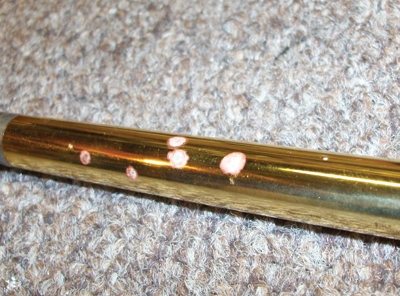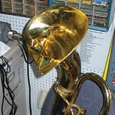Some basic knowledge of instrument maintenance can help directors keep student instruments in good condition and avoid some costly repairs.
Cleaning Instruments
Woodwind players can swab their instruments out after each use, but brass players can only drain the moisture through the water keys. Because this is not as thorough as swabbing, brass instruments should receive regular baths. I teach fifth grade brass players how to disassemble, clean, and lubricate their instruments. They should do this every month, but once or twice a year is enough to avoid most problems. I supply valve oil and slide grease in the band room to help them keep the moving parts working. The golden brown wheel bearing grease from auto parts stores can be used to grease tuning slides.
Along with regular baths, brass instruments should be sent for a chemical cleaning once a year to remove calcium and other build up from the brass tubing. A chemical clean involves disassembling the instrument and pulling stuck slides as necessary, removing grease from the body and parts, cleaning the pieces in a mild acid bath, and rinsing it all with water. Before reassembling the instrument, the technician will replace the water key corks, stem felts, and cap felts, remove major bell dents, grease the slides, oil the valves, re-round the mouthpiece shank, polish the mouthpiece, and play-test the instrument. Without regular cleaning, slides begin to stick and red rot develops.

If pulling on a stuck slide with bare hands does not work, try wrapping a handkerchief around it and pulling. If this does not remove the slide, stop there and send it to a repair tech. Improper tools will damage the instrument. In the worst cases, the stuck slide can be unsoldered, pulled, and resoldered. This problem can be easily avoided if students apply new slide grease every week or two.
Red rot, or dezincification, seems to be less common on newer brass instruments, but occurs as pink spots on a brass mouthpipe or main tuning slide. This indicates that zinc has leaked out of the brass, leaving little spots of pink copper. These spots are thin and weak and can develop into small pin holes. The only solution to red rot is to replace the old mouthpipe or slide. I pass around a red-rotted trumpet mouthpipe to beginning brass players before I demonstrate how to clean instruments, hoping that this encourages students to do so regularly.
Broken Joints
The solder joints that break most often on brass instruments are on the brace that connects the mouthpipe to the bell. If a solder joint breaks before a marching performance or concert, there are a few ways to fix it temporarily. Fastening the joint together with rotary valve string, Velcro, a strapping belt, or a rag should hold it for the length of a performance. Duct tape and athletic tape leave a sticky residue that is difficult to clean off, and super glue is more difficult to remove. Rubber bands contain sulfur that will eat away at silver plating. The instrument should be sent to a repair shop as soon as possible because the stress caused by the broken brace can twist the instrument, leading to alignment problems and damaging other braces.
Dents
A dent in a valve casing or trombone slide should only be repaired by a professional because forcing a stuck valve up will result in additional damage. Someone once brought a baritone for repair that had a valve stuck down. When I unscrewed the bottom cap, I found a screwdriver-shaped hole in the bottom of the piston from a failed attempt to loosen the valve. Instead of paying to repair a stuck valve, that director had to buy a new piston.
Dents in the small tubing including the mouthpipe and tuning slides affect the sound more than bell dents. In repair school, the rule of thumb is if a dent is more than 1⁄3 the diameter of the tube, it should be repaired. These small tubing dents are generally harder to reach and are thus more expensive. Dents in the bell are mostly cosmetic but are relatively easy to reach and inexpensive to repair.
Brass Mouthpieces
Dents in the mouthpiece shank can cause air leaks because the mouthpiece no longer fits in the receiver correctly. The repair is usually simple and inexpensive. Dings in the mouthpiece rim or cup can cut the lips or expose leaded brass, causing irritation or infection. Mouthpieces with damaged plating should be replaced.
Students or parents should never try to pull stuck mouthpieces with common household tools. The mouthpipe and soldered braces are not even strong enough to take the full force that could be applied with an adult’s bare hands. Pulling a stuck mouthpiece the right way is cheap, but it can cost well over $200 to replace a twisted mouthpipe, three broken braces, and a mouthpiece damaged by pliers. Directors should get a mouthpiece puller to keep at school and offer to pull students’ mouthpieces for free.
Woodwind Keys
Broken or binding woodwind keys are difficult to repair without training, but a technician can silver-solder a broken key easily. Many cheap instruments found online are difficult to repair because the keys are made out of low-quality pot metal. This metal melts at the same temperature as the silver solder, so when a technician heats the key to apply the solder, the pot metal turns to liquid. I tell parents that if they want to save money it is better to buy a good-quality used instrument than a low-quality new one. Used instruments may not look as nice, but they will last much longer.
Brass Alloys
Brass is an alloy made by thoroughly dissolving the base metals copper and zinc into each other. The alloy has a lower melting point and is stronger than either base metal.
The most common alloy used in brass instruments, yellow brass, uses 70% copper and 30% zinc. It can be used for most instrument parts and is sometimes called cartridge brass.
Less commonly used is red brass, also called rose brass or gold brass, which is 80% copper and 20% zinc. It is mostly used in bells and mouthpipes.
Leaded brass is used in mouthpieces and other machined parts. It contains 2-5% lead to make it easier to machine, so it has to be plated with silver or another precious metal to prevent the lead from irritating the skin or lips.
Nickel silver, sometimes called German silver or nickel brass, is used in slide tubing. Composed of copper, zinc, and nickel, this alloy is silver-gray in color.
Leaded nickel silver is used to make woodwind keys, flute bodies, and brass parts such as valve caps, finger buttons, finger hooks, and piston valves. It is either lacquered or plated with nickel or silver to prevent tarnishing.
Monel is an alloy of nickel, and copper with small amounts of iron and aluminum that is sometimes chosen for trumpet valves because it is hard, corrosion-resistant, and strong enough to be machined to precise tolerances. Monel valves have a dull finish and brass ports, but many student instruments use nickel silver plated with nickel, which has a uniform shiny silver finish. Many professionals prefer monel, but nickel-plated valves are easier to keep clean and therefore better for most students.
Bearing bronze, an alloy of copper, tin, zinc, and lead, is used for making horn and trombone rotors and bearing plates. Occasionally, instrument bells are made of solid copper (coprion) or sterling silver.
Brass instruments are assembled by soldering or brazing. Soft solder is used where low strength is acceptable. Soft solder is usually made of 60% lead and 40% tin and flows at about 400°F. A flux of zinc chloride or glycerin and muriatic acid helps the solder stay in the correct place until it has hardened.
Brazing is used to connect bell parts on brass instruments. Made of 50% copper and 50% zinc, it is much stronger than solder and melts at around 1500°F.
Silver solder is used for piston casings, pistons, small braces, and woodwind keys where strength and a silver color are required. It is basically a brazing material with 10-45% silver added. Its melting point fanger from 1100°F to 1400°F.
Welding is distinct from soldering and brazing because it involves actually melting the workpieces and adding a filler to form a pool of molten material that bonds the parts. This is done at temperatures of 3000°F and higher. Plasma welding is used on some brass bells.
Students should be diligent about swabbing and cleaning their instruments. Be sure students know to inform you if anything on the instrument breaks. Parents should be strongly discouraged from attempting instrument repair on their own; this is best left to the director or professional repairmen.
Do you have an instrument repair horror story? Email us at editor@theinstrumentalist.com.






